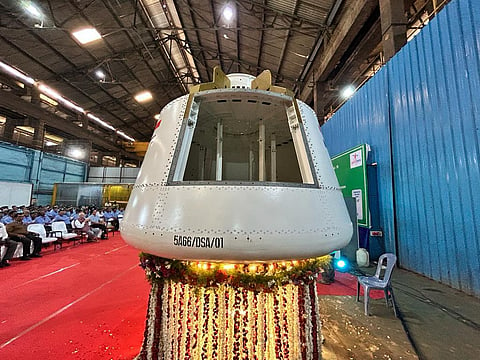

CHENNAI: The preparations for the Gaganyaan mission are in full swing. The project envisages a demonstration of human spaceflight capability by launching a 3-member crew to an orbit of 400 km for a 3-day mission and bringing them back safely to earth, by landing in Indian sea waters.
The Crew Module (CM) for the mission is in different stages of development. The first development flight Test Vehicle (TV-D1) is in the final stages of preparation. The Test Vehicle is a single-stage liquid rocket developed for this abort mission. The payloads consist of the Crew Module and Crew Escape Systems (CES) with their fast-acting solid motors, along with CM fairing (CMF) and Interface Adapters.
This flight will simulate the abort condition during the ascent trajectory corresponding to a Mach number of 1.2 encountered in the Gaganyaan mission. CES with CM will be separated from the Test Vehicle at an altitude of about 17 km. Subsequently, the abort sequence will be executed autonomously commencing with the separation of CES and deployment of the series of parachutes, finally culminating in the safe touchdown of CM in the sea, about 10 km from the coast of Sriharikota, the ISRO said.
Private participation or role of KCP Ltd
Meanwhile, as a part of the ongoing works relating to the mission, the Chennai-based heavy engineering unit of KCP Ltd on Saturday officially handed over the crew module structure for the Integrated Air-Drop Test.
R Hutton, Acting Director of ISRO's Human Space Flight Centre (HSFC), received the module from Indira Dutt, chairman and managing director of KCP Group, and lauded the engineering prowess of the firm, whose association with ISRO spans over three decades.
On the sidelines, Hutton said the integrated air-drop test is one of the important exercises in evaluating the various systems of Gaganyaan.
"What we are seeing today is a single-wall crew module. In the original module, it will be a dual wall. The purpose of this module is to validate the parachute system that we will be using for deceleration. There will be different kinds of parachutes that we will be using at different altitudes and at a specific sequence. Using this module, we will be validating the end-to-end sequential performance of the parachute system."
To a query, Hutton said, when the crew module is orbiting the earth, it will be traveling at 7.5 km per second and that speed has to be brought down to 8.5 meters per second for a safe touchdown. This is the physiological limits of the crew members. For the test, this crew module will be dropped vertically by an Indian Air Force Chinook heavy-lift helicopter from an altitude of about 4 km.
According to the firm, this crew module structure weighs 3.1 tonnes, measures 3.1 metre in diameter, stands 2.6 metre tall, and is made using a light alloy of aluminum and 15CDV6 steel. The KCP will be manufacturing another crew module for ISRO which will be delivered by March 2024 after incorporating any necessary changes that the space agency suggests.
ALSO READ | Gaganyaan crew wrap up phase-1 training
Meanwhile, ISRO announced that it was gearing up for the first Test Vehicle Abort mission-1, which will carry an unpressurized crew module. It has completed its integration and testing and is ready to be shipped to the launch complex in Sriharikota.
"This unpressurized crew module version has to have an overall size and mass of the actual Gaganyaan Crew Module (CM). It houses all the systems for the deceleration and recovery. With its complete set of parachutes, recovery aids, actuation systems and pyros. The avionics systems in CM are in a dual redundant mode configuration for navigation, sequencing, telemetry, instrumentation and power. The Crew Module in this mission is extensively instrumented to capture the flight data for evaluation of the performance of various systems. The Crew Module will be recovered after touchdown in the Bay of Bengal, using a dedicated vessel and diving team from the Indian Navy," the ISRO said.